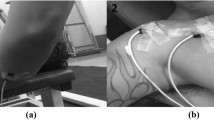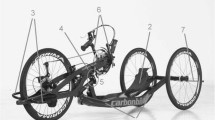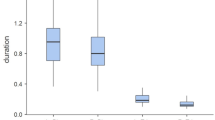Abstract
This study aimed at investigating the relationship between the trunk and upper limb muscle coordination and mass of the tennis racket during forehand drive. A total of 15 male tennis players performed seven series of ten crosscourt forehand drives, both with their personal racket and six rackets with increased mass ranging from 6 to 16% (step = 2%) of their personal racket mass. The electromyographic (EMG) activity was recorded from nine trunk and upper limb muscles. The onset before impact and EMGrms values of the bursts were individually calculated. Results showed that the ball speed and the muscle activation temporal sequences were similar, whatever the increase in racket mass. Interestingly, in all participants, the activation level of the pectoralis major, latissimus dorsi and biceps brachii decreased when the racket mass increased, while the variations in the anterior deltoid activation level were correlated to the individual personal racket mass. These findings strongly suggest that the study of muscle activity during tennis practice should be considered as a complementary technique to determine a better adequacy of the racket characteristics to those of the player.








Similar content being viewed by others
References
Akaike H (1974) A new look at statistical model identification. IEEE Trans Automat Contr AU19:716–722
Barrass DF, Jones R, Disckens P, Hague R, Roberts J (2007) Tennis handle customization using rapid manufacturing methodologies. In: Miller S, Capel-Davies J (eds) Tennis science and technology 3. ITF, London, pp 93–101
Bower R, Cross R (2003) Player sensitivity to changes in string tension in a tennis racket. J Sci Med Sport 6:120–131
Brody H (2000) Player sensitivity to the moments of inertia of a tennis racket. Sports Eng 3:145–148
Cardoso Marques M (2005) Strength training in adult elite tennis players. Strength Cond J 27:34–41
Chester S, Boatwright D (1993) Training methods using various weighted bats and the effects on bat velocity. J Strength Cond Res 7:115–117
Cross R (1999) The bounce of a ball. Am J Phys 67:222–227
Cross R (2001) Customising a tennis racket by adding weights. Sports Eng 4:1–14
Cross R (2004) Physics of overarm throwing. Am J Phys 72:305–312
Cross R, Bower R (2006) Effects of swing-weight on swing speed and racket power. J Sports Sci 24:23–30
DeRenne C, Buxton BP, Hetzler RK et al (1995) Effects of weighted bat implement training on bat swing velocity. J Strength Cond Res 9:247–250
Dinu D, Levêque JM, Natta F et al (2004) Evolution of kinematical and electromyographic parameters during the different phases of a discus throw: a preliminary study. Sci Sports 19:189–192
Elliott BC, Marsh T, Overheu P (1989) A biomechanical comparison of the multisegment and single unit topspin forehand drives in tennis. Int J Sport Biomech 5:350–364
Escamilla RF, Fleisig GS, Barrentine SW et al (2000) Effects of throwing overweight and underweight baseballs in throwing velocity and accuracy. Sports Med 29:259–272
Faure N (2008) Technological and marketing innovations for female players: the airflow concept. In: Bayle E, Crognier L (eds) Le tennis dans la société de demain. UFRSTAPS, Dijon, pp 58–59
Hermens HJ, Freriks B, Disselhorst-Klug C, Rau G (2000) Development of recommendations for SEMG sensors and sensor placement procedures. J Electromyogr Kinesiol 10:361–374
Kibler WB, Chandler TJ, Shapiro R, Conuel M (2007) Muscle activation in coupled scapulohumeral motions in the high performance tennis serve. Br J Sports Med 41:745–749
Marx RG, Sperling JW, Cardasco FA (2001) Overuse injuries of the upper limb extremity in tennis players. Clin Sports Med 20:439–451
Mitchell SR, Jones R, King M (2000) Head speed vs. racket inertia in the tennis serve. Sports Eng 3:99–110
Pinheiro JC, Bates DM (2000) Mixed-effects models in S and S-plus. Springer, New York
Rouffet D, Hautier CA, Brosseau O, Rogowski I (2009) Muscle coordination during topspin forehand drive in young tennis players. Sci Sports 24:111–114
Ryu R, McCormick J, Jobe F, Moynes D, Antonelli D (1988) An electromyographic analysis of shoulder function in tennis players. Am J Sports Med 16:481–485
Takahashi K, Elliott BC, Noffal G (1996) The role of upper limb segment rotations in the development of spin in the tennis forehand. Aust J Sci Med Sport 28:106–113
Acknowledgments
The authors thank the society Babolat VS for providing and customizing the rackets Babolat Pure Drive. The authors also thank the SIUAPS of Lyon University for providing the tennis court in the gymnasium. This work was supported by the society Prepaphysiqueonline (Lyon, France) and OSEO (regional delegation, Lyon, France)-J0811020V.
Author information
Authors and Affiliations
Corresponding author
Rights and permissions
About this article
Cite this article
Rogowski, I., Creveaux, T., Faucon, A. et al. Relationship between muscle coordination and racket mass during forehand drive in tennis. Eur J Appl Physiol 107, 289–298 (2009). https://doi.org/10.1007/s00421-009-1124-4
Accepted:
Published:
Issue Date:
DOI: https://doi.org/10.1007/s00421-009-1124-4




